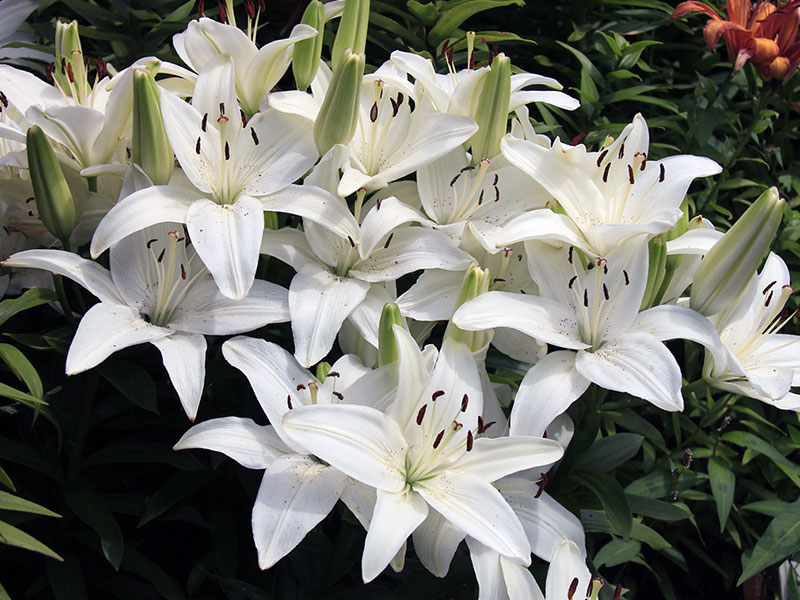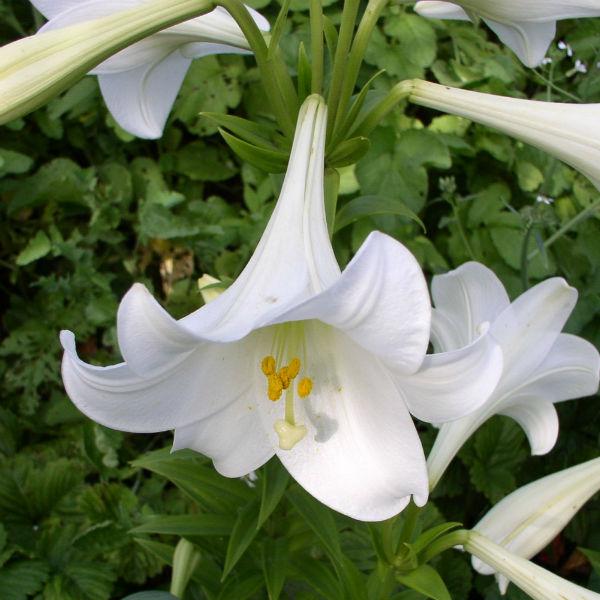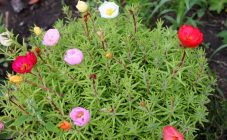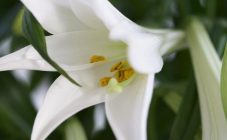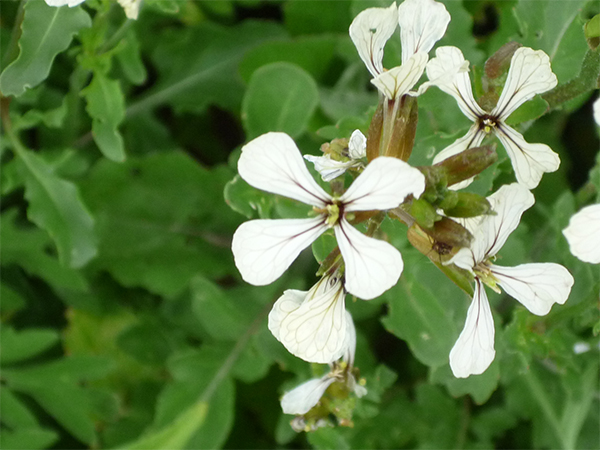Content:
In many garden plots, balconies and window sills, you can see a beautiful flower - a lily. There are many different varieties of this plant, each of which has its own characteristics and charms. If we tell all about lilies: what are the lilies, what does the lily flower mean, it will take a lot of time.
Lily: the meaning of the flower
What does lily mean? There is an opinion that the flower got its name from the ancient Gauls, which in translation from the ancient Gaul language means "white-white". She symbolizes purity and integrity.
In Ancient Greece, Rome and Egypt, the image of a lily could be found on frescoes and household items. The capital of distant Persia, the city of Susa was called the city of lilies.
There are many legends and beliefs associated with this beautiful plant. For example, as one of the Greek legends says, the lily appeared from the drops of milk of the wife of the sea king Zeus, Hera.
In all images, the god Thor was depicted with a scepter decorated with lilies. In German fairy tales, it was said that each flower has its own elf, who at night arranged a fabulous chime from lily bells and read prayers.
After the advent of Christianity, the lily was considered the flower of the Virgin Mary and symbolized purity and innocence. Many Christian saints depict a wreath or bouquet of lilies.
The lily was especially loved in France. The flower had great heraldic significance: its image was on the coat of arms and flag of the country. The lily was also engraved on French coins.
Plant use
Lily flowers contain many active substances. Among the most important are the following:
- proteins;
- carbohydrates;
- mucous substances;
- saponins;
- flavonoids;
- alkaloids;
- magnesium;
- vitamin C;
- tannins;
- boron;
- iron.
Lily pollen contains carotene, which normalizes the functioning of the optic nerve.
Lilies are popular in Turkish and Chinese cuisine.
Lily is a plant that has many beneficial properties:
- Pain reliever.
- Sedative.
- Calming.
- Expectorant.
- Antimicrobial.
- Regenerating.
Often, flowers are included by folk healers in the composition of ointments and tinctures.
Lily is a flower grown in Japan as a vegetable. In the Far East, the bulbs of some plant varieties are used for food.
In cosmetology, tinctures and extracts from the bulbs of these flowers are used. They make the skin younger, give it elasticity and tone.
Description and varieties
Lilies are bulbous flowers, belong to the Liliaceae family. Their stems are erect, the height ranges from 60-185 cm. Rounded bulbs can be scaly or bare. Their structure consists of several teeth that fit snugly around each other. The depth of the bulb depends on the plant variety. The root system departs from the bottom, which looks like a highly developed white bundle.
On the stem are sessile leaves that are lanceolate. Their width can be in the range from 1.5 to 2.5 cm, and their length is no more than 20 cm.
Flowers can be arranged singly, and can be collected in 3-40 pieces in an umbrella inflorescence. The funnel-shaped perianth is composed of 6 parts. The color of the peduncles can be varied: from white or yellow to brindle.
The lily fruit is a box. Seeds of triangular shape are small (up to 5 mm). They are also lightweight, which facilitates their spread over long distances.
Today more than 30 species of lilies are known. When classifying them, different criteria are used: what the lilies look like, where the lilies grow, etc.
According to the flower shape of garden plants, they are divided into the following types:
- cupped;
- funnel-like;
- with elongated petals.
More than 10 thousand varieties of lilies are combined into 7 hybrid groups:
- Asian.
- Curly.
- Snow white.
- American.
- Long-flowered.
- Tubular.
- Eastern.
There are varieties adapted for indoor cultivation, as well as for outdoor cultivation.
Care and reproduction
The popularity of the flower is due not only to its beautiful flowers, but also to its ease of care and cultivation. For reproduction, you can use both seeds and bulbs. The first method makes it possible to obtain plants with a strong immune system. But it will be possible to see the first flowering only after 5-6 years.
Before planting, the bulbs must be externally inspected for cracks, rot, dry scales and roots. To prevent the development of fungal diseases, it is recommended to soak the bulbs for 24 hours in a solution of potassium permanganate or karbofos before planting in the ground.
Bulbs can be planted in open ground in both autumn and spring. The area in the garden where it is planned to grow lilies should be well lit and protected from the wind. The sun's rays should not constantly fall on the site, but the shade will also lead to the fact that the stems will stretch, and the flowering period will be reduced several times. Lilies will thrive on light, well-drained soils. The soil pH indicator should be neutral or close to it.
The use of manure for the preparation of soil mixture will lead to active growth of the ground part of the plant. It is better to use a special soil for bulbous.
The distance between the holes should be between 10-20 cm. The planting depth of the bulbs depends on the variety. It can vary from 10 to 25 cm. A 3-5 cm thick layer of sand is poured onto the bottom of each hole. The roots of the bulb are gently straightened out, and the hole is covered with earth.
Taking care of a lily in the garden is easy. Since the plant is tropical, it has the ability to easily tolerate dry periods. Waterlogged soil can provoke the development of fungal diseases of the plant. You need to water the plant every day. It is better to do this in the morning or evening. Otherwise, the possibility of sunburn on the leaves is not excluded.
In the spring, the area with lilies is fed with complex mineral fertilizers containing ammonium nitrate and nitrogen. After 3-4 weeks, superphosphate can be added to the beds. Thanks to this, flower buds will grow much more actively. After the end of the flowering period, lilies should be fed with mineral fertilizers.
In one place, a lily can grow for 5-7 years. After that, it is necessary to transplant it.Otherwise, the lily will stop blooming. For transplanting, the bulbs are carefully dug out. They need to be washed from the ground and dried well, for disinfection purposes, treated with a weak solution of potassium permanganate or karbofos. The bulbs are then stored at home in a cool place, such as in the refrigerator or basement. When transplanting, the bulb is divided into several parts, each of which will give life to a new plant.
Home conditions also make it possible to propagate lilies by seed. To do this, you need to leave several boxes in which the seeds will ripen over time. They are sown in soil mixture for bulbous plants and covered with a transparent film. The soil is watered as it dries. After 4-5 weeks, the first shoots will appear. The cover can now be removed. After the development of the first 2-3 leaves, young plants are transplanted into separate containers. In early spring, when there will be no more frosts, the seedlings can be planted in open ground.
For the winter, lilies need insulation. To do this, you can use spruce branches or dry leaves. The possibility of using a thick layer of peat as a heater is also not excluded, which after the snow melts will be used by the plant as a fertilizer.
Pests and diseases of lilies
Despite the fact that the immune system of flowers is strong enough, they can still get sick and be attacked by harmful insects. Among the most common diseases of lilies are red rot. It affects flowers that grow in moist soils at low temperatures. The disease affects the bulb, on which putrid spots appear. To save it, you need to remove the stain and disinfect it with a fungicide solution.
Plants often infect fungal diseases:
- rust,
- gray rot,
- fusarium.
For the prevention of the disease, the bulbs are treated with Euporen, Fundazol or Topsin before planting in the ground. They can also be sprayed on the plant during the growing season.
Among the most common pests can be distinguished mealybug, spider mite, scale insect. To destroy them, flowers are sprayed with insecticides.
To prevent the development of a root mite, before planting, the planting material is treated with a solution of potassium permanganate or karbofos. Timely destruction of weeds on the site and loosening of the soil will help to cope with such a pest as the onion leaf beetle. Good results can also be achieved through the use of chlorophos.
Lily leaves begin to wither quickly when there is an excess of moisture in the ground. If the air temperature is low, the peduncles become dark. When plants are grown in strong sun, the flowers become pale and fall off quickly. In order to prevent such unpleasant situations, experienced gardeners recommend constantly monitoring the appearance of plants, following all the rules for caring for them.
Attention and love will bring beauty and fragrance of lilies throughout the summer.
